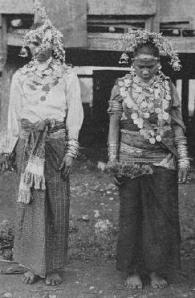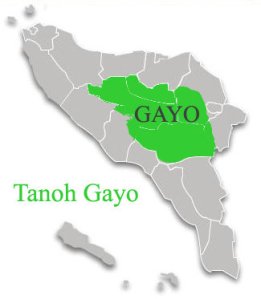august 29 2009
ETHNONYMS: Gayo, Gajo, urang Gayó, Gayonese
Orientation
Identification. The Gayo live predominantly in the central highlands of Aceh Province in Sumatra, Indonesia, and are Sunni Muslims. Gayo refer to themselves as “Urang Gayo,” meaning “Gayo people,” primarily on grounds of command of basa Gayo, the Gayo language.

Location. The Gayo homeland lies across the Bukit Barisan Range in Aceh Province, between 40 and 5° N and 96° and 980 E. The range divides the homeland into four plateaus, each with a river system along which Gayo have settled. The largest concentration of settlement is the town of Takengen (Takengon) by Lake Lat tawar. The area gradually declines in elevation from about 1,500 meters in the north to about 500 meters in the south. Northeast trade winds bring heavy rains in a four-month period between October and March; the southeast trades can bring a lighter rainfall between April and September.
Demography. The 1980 population of the district of Central Aceh was 163,339, of which about 140,000 were Gayo speakers. In the 1980s about 45,000 Gayo resided in other districts in the Aceh highlands and about 25,000 lived elsewhere in Indonesia, giving a total population of about 210,000 Gayo.
Linguistic Affiliation. The Gayo language belongs to the Western Indonesian Branch of the Austronesian Family and lexically is most closely related to the Batak Subfamily. The presence of Mon-Khmer loanwords suggests early coastal contacts with some Mon-Khmer-language-speaking societies. The earliest known writing in Gayo used the Jawi script (Arabic letters) but since the 1950s most Gayo have used standard Indonesian orthography. By the 1980s most Gayo had at least minimal competence in the Indonesian language.
History and Cultural Relations
Substantial written references to the Gayo only begin in the late nineteenth century. It is likely, however, that the Gayo homeland belonged to the Islamic kingdom of Aceh in the seventeenth century and that Islamization of the area had begun by that time. At the outbreak of the Aceh-Dutch war
in 1873, Gayo possessed a strong sense of ethnic distinctiveness but recognized a nominal Acehnese suzerainty. Some Gayo continued to resist the Dutch after the invasion of the highlands in 1904. During Dutch occupation (1904-1942) Gayo developed a thriving cash-crop economy in vegetables and coffee, attained a relatively high level of basic education,
and participated in the movements of Islamic modernism and Indonesian nationalism. Gayo fought to maintain Continue reading “GAYO”



